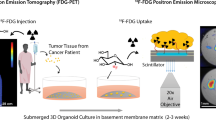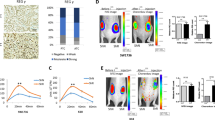Abstract
Radioactive iodide uptake (RAIU) in thyroid follicular epithelial cells, mediated by the sodium iodide symporter (NIS), is the first rate-limiting step in iodide accumulation which provides a mechanism for effective radioiodide treatment for patients with thyroid cancer. We hypothesize that NIS gene transfer to non-thyroid tumor cells will enhance intracellular radioiodide accumulation and result in better tumor control. Here, we performed non-invasive tumor imaging and 131I therapy studies using rats bearing intracerebral F98 gliomas that have been retrovirally transduced with human NIS. Our results show that: (1) NIS is expressed in the intracerebral F98/NIS gliomas; (2) F98/NIS gliomas can be imaged by 99mTcO4 (whose uptake is also mediated by NIS) and 123I scintigraphy; (3) significant amounts of radioiodide were retained in the tumors at 24 h after 123I injection; (4) RAIU and NIS expression in the thyroid gland can be reduced by feeding a thyroxine-supplemented diet; and (5) survival time was increased in rats bearing F98/hNIS tumors by 131I treatment. These studies warrant further investigating tumor imaging and therapeutic strategies based on NIS gene transfer followed by radioiodide administration in a variety of human cancers.
This is a preview of subscription content, access via your institution
Access options
Subscribe to this journal
Receive 12 print issues and online access
$259.00 per year
only $21.58 per issue
Buy this article
- Purchase on Springer Link
- Instant access to full article PDF
Prices may be subject to local taxes which are calculated during checkout






Similar content being viewed by others
References
Smanik PA et al. Cloning of the human sodium iodide symporter Biochem Biophys Res Commun 1996 226: 339–345
Dai G, Levy O, Carrasco N . Cloning and characterization of the thyroid iodide transporter Nature 1996 379: 458–460
Levy O et al. Identification of a structural requirement for thyroid Na+/I− symporter (NIS) function from analysis of a mutation that causes human congenital hypothyroidism FEBS Lett 1998 429: 36–40
Eskandari S et al. Thyroid Na+/I− symporter. Mechanism, stoichiometry, and specificity J Biol Chem 1997 272: 27230–27238
Kotzerke J et al. Pharmacokinetics of 99mTc-pertechnetate and 188Re-perrhenate after oral administration of perchlorate: option for subsequent care after the use of liquid 188Re in a balloon catheter Nucl Med Commun 1998 19: 795–801
Lin WY et al. A comprehensive study on the blockage of thyroid and gastric uptakes of 188Re-perrhenate in endovascular irradiation using liquid-filled balloon to prevent restenosis Nucl Med Biol 2000 27: 83–87
Larsen RH, Slade S, Zalutsky MR . Blocking [211At]astatide accumulation in normal tissues: preliminary evaluation of seven potential compounds Nucl Med Biol 1998 25: 351–357
Cobb LM et al. Relative concentration of astatine-211 and iodine-125 by human fetal thyroid and carcinoma of the thyroid in nude mice Radiother Oncol 1988 13: 203–209
Spitzweg C et al. Prostate-specific antigen (PSA) promoter-driven androgen-inducible expression of sodium iodide symporter in prostate cancer cell lines Cancer Res 1999 59: 2136–2141
Shimura H et al. Iodide uptake and experimental 131I therapy in transplanted undifferentiated thyroid cancer cells expressing the Na+/I− symporter gene Endocrinology 1997 138: 4493–4496
Cho JY et al. Expression and activity of human Na+/I− symporter in human glioma cells by adenovirus-mediated gene delivery Gene Therapy 2000 7: 740–749
Mandell RB, Mandell LZ, Link CJ Jr . Radioisotope concentrator gene therapy using the sodium/iodide symporter gene Cancer Res 1999 59: 661–668
Boland A et al. Adenovirus-mediated transfer of the thyroid sodium/iodide symporter gene into tumors for a targeted radiotherapy Cancer Res 2000 60: 3484–3492
Carlin S et al. Experimental radioiodide therapy following transfection of the sodium iodide symporter gene: effect on clonogenicity in both two- and three-dimensional models Cancer Gene Ther 2000 7: 1529–1536
Goodman JH et al. Inhibition of tumor growth in a glioma model treated with boron neutron capture therapy Neurosurgery 1990 27: 383–388
Clendenon NR et al. Boron neutron capture therapy of a rat glioma Neurosurgery 1990 26: 47–55
Spitzweg C et al. Treatment of prostate cancer by radioiodine therapy after tissue-specific expression of the sodium iodide symporter Cancer Res 2000 60: 6526–6530
Huang M et al. Ectopic expression of the thyroperoxidase gene augments radioiodide uptake and retention mediated by the sodium iodide symporter in non-small cell lung cancer Cancer Gene Ther 2001 8: 612–618
Dadachova E et al. Rhenium-188 as an alternative to iodine-131 for treatment of breast tumors expressing the sodium/iodide symporter (NIS) Nucl Med Biol 2002 29: 13–18
Postema EJ et al. Radioimmunotherapy of B-cell non-Hodgkin's lymphoma Eur J Nucl Med 2001 28: 1725–1735
Wheldon TE . Radiation physics and genetic targeting: new directions for radiotherapy Phys Med Biol 2000 45: R77–R95
Ko L, Koestner A, Wechsler W . Characterization of cell cycle and biological parameters of transplantable glioma cell lines and clones Acta Neuropathol (Berl) 1980 51: 107–111
Ko L, Koestner A, Wechsler W . Morphological characterization of nitrosourea-induced glioma cell lines and clones Acta Neuropathol (Berl) 1980 51: 23–31
Kobayashi N et al. An improved rat brain-tumor model J Neurosurg 1980 53: 808–815
Miller DA, Rosman GJ . Improved retroviral vectors for gene transfer and expression BioTechniques 1989 7: 980–990
Barth RF et al. Boron neutron capture therapy of brain tumors: enhanced survival and cure following blood-brain barrier disruption and intracarotid injection of sodium borocaptate and boronophenylalanine Int J Radiat Oncol Biol Phys 2000 47: 209–218
Jhiang SM et al. An immunohistochemical study of Na+/I− symporter in human thyroid tissues and salivary gland tissues Endocrinology 1998 139: 4416–4419
Cho JY et al. Hormonal regulation of radioiodide uptake activity and Na+/I− symporter expression in mammary glands J Clin Endocrinol Metab 2000 85: 2936–2943
Barth RF et al. Boron neutron capture therapy of brain tumors: enhanced survival following intracarotid injection of either sodium borocaptate or boronophenylalanine with or without blood–brain barrier disruption Cancer Res 1997 57: 1129–1136
Acknowledgements
We thank Dr Kathleen Boris-Lawrie for providing the pLXSN retroviral vector, Mr Steve Lefevre for preparation of radionuclides, and Ms Danielle Westfall for assistance with animal handling.
Author information
Authors and Affiliations
Rights and permissions
About this article
Cite this article
Cho, JY., Shen, D., Yang, W. et al. In vivo imaging and radioiodine therapy following sodium iodide symporter gene transfer in animal model of intracerebral gliomas. Gene Ther 9, 1139–1145 (2002). https://doi.org/10.1038/sj.gt.3301787
Received:
Accepted:
Published:
Issue Date:
DOI: https://doi.org/10.1038/sj.gt.3301787
Keywords
This article is cited by
-
The sodium iodide symporter (NIS) as theranostic gene: its emerging role in new imaging modalities and non-viral gene therapy
EJNMMI Research (2022)
-
Virotheranostics, a double-barreled viral gun pointed toward cancer; ready to shoot?
Cancer Cell International (2020)
-
A Novel Ideal Radionuclide Imaging System for Non-invasively Cell Monitoring built on Baculovirus Backbone by Introducing Sleeping Beauty Transposon
Scientific Reports (2017)
-
Development of a novel imaging system for cell therapy in the brain
Stem Cell Research & Therapy (2015)
-
Glial fibrillary acidic protein promoters direct adenovirus early 1A gene and human telomerase reverse transcriptase promoters direct sodium iodide symporter expression for malignant glioma radioiodine therapy
Molecular and Cellular Biochemistry (2015)



